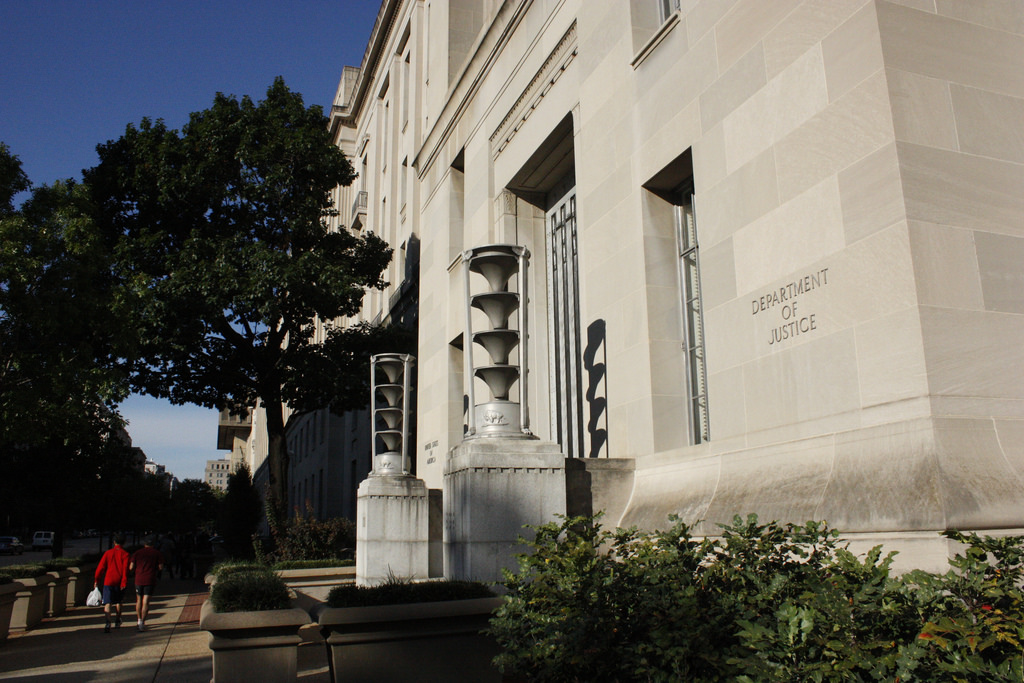The Trump Administration and Executive Power: Evidence from Justice Department Views Letters
The executive branch has several ways of asserting exclusive presidential powers. Presidential signing statements, memoranda from the Office of Legal Counsel (OLC), legal briefs—these are well-studied tools of executive claims-staking. The use of these tools in the Trump administration has received plenty of coverage on this blog and others.

Published by The Lawfare Institute
in Cooperation With

The executive branch has several ways of asserting exclusive presidential powers. Presidential signing statements, memoranda from the Office of Legal Counsel (OLC), legal briefs—these are well-studied tools of executive claims-staking. The use of these tools in the Trump administration has received plenty of coverage on this blog and others.
But the executive branch makes use of a less-studied tool, too: Justice Department views letters. These are letters sent by the Department of Justice to members of Congress expressing the department’s “views” on draft legislation. Some of these views relate to policy, but we focus here on views about the constitutional division of power between Congress and the president. A comparison of the Justice Department views letters sent during the first two years of the Trump administration with those sent during the first two years of the Obama administration, indicates that the Trump administration has been considerably more energetic in asserting exclusive presidential powers.
Justice Department Views Letters: A Primer
Views letters are a long-standing mechanism by which agencies may provide their views to Congress on draft legislation. The Justice Department views letters that we focus on are sent over the signature of the assistant attorney general for legislative affairs, though constitutional claims within them are likely drafted by the OLC, the preeminent source of legal guidance in the executive branch. They are addressed to members of Congress—usually committee chairs, but also bill sponsors or leadership, depending on where a given bill is in the process.
Justice Department views letters typically start by stating their purpose of presenting “the views of the Department of Justice” on a given piece of pending legislation. They go on to pronounce on the policy content and/or the constitutionality of various provisions in the bill. In this way, Justice Department views letters serve a dual function: advocacy for executive policy priorities and counsel on the legality of selected provisions.
To date, Justice Department views letters have received little attention from scholars, but we think they are worthy of study for three reasons.
First, Justice Department views letters represent a mechanism of executive influence over congressional lawmaking. We intend to pursue further research on what kind of impact they have on the actual substance of legislation—particularly whether they influence draft provisions that bear on executive power. This is all the more interesting to the extent that the OLC sees itself as counsel to the executive branch, duty-bound to protect its institutional power, rather than as a neutral arbiter of the law.
Second, and related, Justice Department views letters can predict or shed light on specific signing statements. For example, the Trump administration sent a views letter on the National Defense Authorization Act (NDAA) for fiscal 2018 previewing, in substantial detail, the objections President Trump stated in his signing statement for the final bill. To the extent that signing statements are an important way by which presidents make constitutional claims about exclusive executive powers, views letters are an important precursor in this process.
Third, Justice Department views letters may yield insights into differing views of executive power over time. Justice Department views letters probably never cross the desk of the president, but they can nevertheless reflect variance in legal positions across administrations. The same is true of signing statements. For example, President Obama’s signing statement for the NDAA for fiscal 2017 was more limited in its objections than was Trump’s signing statement for the NDAA the following year.
Comparing Justice Department Views Letters from the Trump Administration and the Obama Administration
Views letters from the first two years of the Trump administration and the first two years of the Obama administration are publicly available on the Justice Department website. (As part of a larger project, we are also trying to gather as many Justice Department views letters as we can from earlier years through the Freedom of Information Act and other research tools.) We identified 23 such views letters from the first two years of the Obama administration and 27 from the Trump administration. We assume that this is a complete set, although we cannot be sure.
Our top-line finding is that the Trump administration has used views letters to assert and protect executive privileges much more than the Obama administration did—even though, from a party perspective, both presidents had unified governments during these periods. During the first two years of the Obama administration, four of the 23 views letters sent to Congress expressed concerns about encroachments on executive power, compared to 22 out of the 27 views letters sent during the Trump administration. Meanwhile, both administrations sent letters expressing concerns about other constitutional issues unrelated to executive power (e.g., the Ex Post Facto Clause) at roughly the same rate. (See Figure 1.)

Where the Justice Department used views letters to express concern that a provision of a bill infringed on exclusive executive power, we identified several buckets of commonly used constitutional bases for these objections. Two of these buckets were perceived encroachments on the president’s national security powers (e.g., powers as commander in chief) and on the president’s diplomatic powers (e.g., the power to receive ambassadors or to negotiate on behalf of the United States). We found that the Trump administration has been particularly ready to assert executive privileges in these areas: more than half of the views letters it sent that expressed separation-of-powers concerns contained at least one objection to a perceived encroachment on the president’s national security powers (12 out of 22, or 55 percent), and more than two-thirds contained at least one objection to a perceived encroachment on the president’s diplomatic powers (15 out of 22, or 68 percent). By comparison, the Obama administration sent two letters expressing national security power concerns and one expressing diplomatic power concerns during its first two years.
Two other buckets of constitutional separation-of-powers objections involved the Recommendations Clause (the responsibility to make legislative recommendations to Congress) and the Appointments Clause (the power to nominate high-level government officials). The Trump administration also sent more views letters expressing objections in these areas: six letters included objections to perceived encroachments on presidential powers under the Recommendations Clause and six included objections under the Appointments Clause, compared to two and one, respectively, during the first two years of the Obama administration. Finally, we dropped other separation-of-powers objections that didn’t fit neatly into any of these categories (e.g., an anti-aggrandizement principle) into a catch-all “other” category. The Trump administration sent eight letters expressing objections in this category during its first two years, compared to two such letters during the comparable period of the Obama administration.
Figure 2 illustrates the relative frequency with which the Justice Department used views letters to express objections in each of these categories and how that frequency changed between the first two years of the Obama and Trump administrations. Letters often contained more than one kind of objection. (Letters often also contained multiple objections of the same category—e.g., a single letter containing objections to multiple bill sections as encroaching on the president’s diplomatic powers—but this blog post does not capture this variation.)

The data show that, at a high level of generality, both administrations relied on similar constitutional arguments to assert exclusive executive powers, albeit with starkly different frequencies. We need to do more work to determine whether there were differences in the scope of the arguments made. As one initial impression, however, the Trump administration’s letters appear to use stronger language. The Obama administration commonly used language stating the administration’s intent to interpret a provision consistent with its conception of the relevant executive power, or couching an objection as only relevant “[i]nsofar as [a provision] purport[s] to” do a particular thing. Only less commonly did it use stronger language—for example, declaring that a “provision violates separation of powers principles.” By contrast, flat declarations of unconstitutionality seem proportionally more common in Trump administration letters, although these letters often use more moderate language too.
Implications
We can’t say for sure what drives the significant disparity between the Obama administration and the Trump administration in the extent of their use of views letters to protect executive power. It could be that more legislative haggling occurred through informal channels during the Obama administration, while the Trump administration has more often resorted to formal instruments like views letters. It could be that the Republican Congress of 2017–18 tried to do more to inhibit executive power than did the Democratic Congress of 2009–10, whether due to more distrust of the specific president, comparatively speaking, or to other reasons. These are possibilities, but we are skeptical that they account for the full difference.
Another explanation, more plausible and intuitive to us, is that the heightened use of views letters reflects more expansive and assertive views of executive power within the Justice Department in the current administration. This more expansive view of executive power will get another powerful advocate in the likely event that the Senate votes to confirm William Barr as attorney general. The Judiciary Committee vote was reportedly postponed until Feb. 7, in response to concerns about his nomination voiced by Democrats on the panel.
The senators raised concerns about Barr’s expansive view of how executive power and privileges could insulate President Trump from consequences stemming from Special Counsel Robert Mueller’s investigation. Their concerns were based in part on a reportedly unsolicited memo Barr wrote to the Trump legal team in June 2018. Barr argued that “Mueller should not be permitted to demand that the President submit to interrogation about alleged obstruction” of justice and contended that using facially lawful presidential acts—like the firing of James Comey as FBI director—as the basis for obstruction charges would impermissibly infringe on the president’s constitutional authority over law enforcement matters.
But Barr’s broad view of executive power, and specifically executive power vis-a-vis Congress’s legislative power, extends far beyond matters of law enforcement. In another memo Barr wrote, this time when he was assistant attorney general in charge of the OLC in July 1989, he outlined 10 “ways Congress most often intrudes or attempts to intrude into the functions and responsibilities assigned by the Constitution to the executive branch.” The list included encroachments on the president’s national security and diplomatic powers, as well as executive authority under the Recommendations Clause and Appointments Clause, among other areas. Addressed to a group of executive branch general counsels, Barr’s memo warned that “[o]nly by consistently and forcefully resisting such congressional incursions can executive branch prerogatives be preserved” because “the methods of intruding on executive power are limited only by Congress’s imagination.”
The views letters in the current Justice Department already advance this agenda. It remains to be seen if they will do so even more in the two years ahead.






